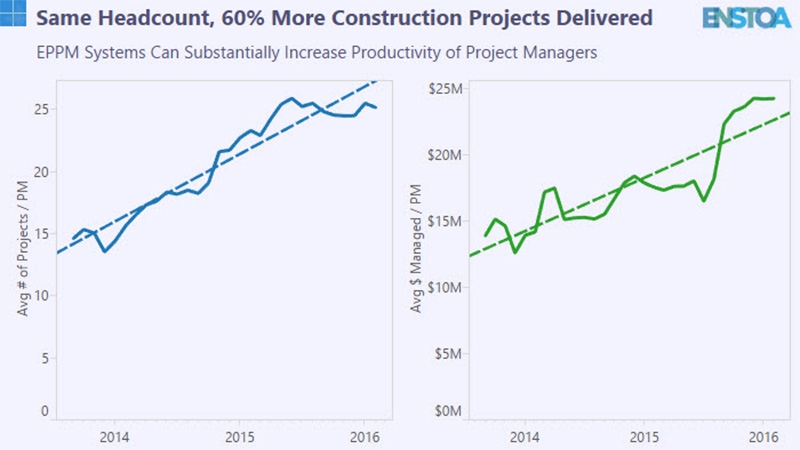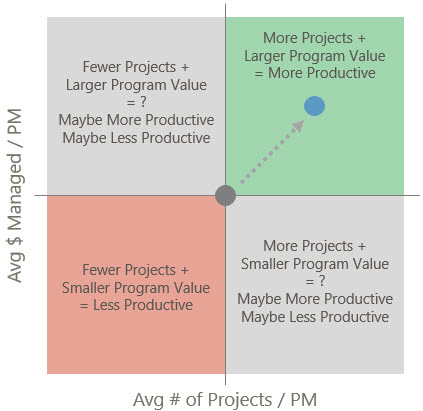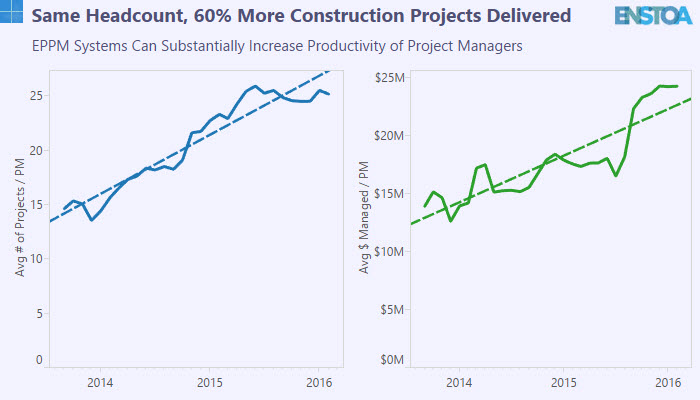
Same Headcount, 60% More Construction Projects Delivered
Vice President at Enstoa
In a prior blog post “Do a Multi-million Dollar Capital Project for Free” we explored how enterprise project management (EPPM) systems can prevent latent capital and make your dollars more productive. These systems can do the same for your team members.
Quantifying Productivity
Determining changes in productivity among project managers (PMs) can be difficult, and we propose two metrics should be evaluated, in concert, to characterize productivity:
- Number of projects managed per project manager
- Total program budget managed per project manager
The figure below, plotting these two metrics shows the baseline of a project manager’s performance at the center. When these metrics are both increasing or are both decreasing we are more certain that productivity is increasing or decreasing. However, if one is increasing and one is decreasing it’s much more difficult to evaluate the change in productivity, which is why looking at these metrics individually doesn’t provide a complete picture of a project manager’s productivity.

Up, Up and Away
With an EPPM system deployed, we observed that organizations dramatically increased project manager productivity. In the example below, PMs managed 60-70% more projects and more program budget within 2.5 years of the EPPM go-live. Organizations are able to deliver significantly more projects without increasing headcount, leading to substantial resource savings for the owner.

Productivity Drivers
Having a system that captures all project activity across the enterprise makes it easier to track trends in these metrics. However, a system alone may not ensure such productivity improvements.
What then drives such significant improvements? We observe three key enabling factors that EPPM systems offer:
- Standard processes are enforced by the system – processes that short circuit control points and visibility go the way of the dodo, and team members are provided with a clear map of what must happen—and when—in the delivery of projects
- Automated processes – these systems can automatically trigger alerts, generate records, or send out emails to better inform the project team of key events
- Immediate data validation – invalid data is prevented from getting in the system where it could cause a chain of confusion and distraction
Organizations, however, cannot simply layer technology on top of bad processes and expect dramatic improvements. Substantial productivity gains are realized when organizations modernize and streamline their project delivery processes to take advantage of the EPPM system features—control points, security, and dynamic alerts, among others—that support these project delivery processes.
In a prior blog post “Do a Multi-million Dollar Capital Project for Free” we explored how enterprise project management (EPPM) systems can prevent latent capital and make your dollars more productive. These systems can do the same for your team members.
Quantifying Productivity
Determining changes in productivity among project managers (PMs) can be difficult, and we propose two metrics should be evaluated, in concert, to characterize productivity:
- Number of projects managed per project manager
- Total program budget managed per project manager
The figure below, plotting these two metrics shows the baseline of a project manager’s performance at the center. When these metrics are both increasing or are both decreasing we are more certain that productivity is increasing or decreasing. However, if one is increasing and one is decreasing it’s much more difficult to evaluate the change in productivity, which is why looking at these metrics individually doesn’t provide a complete picture of a project manager’s productivity.

Up, Up and Away
With an EPPM system deployed, we observed that organizations dramatically increased project manager productivity. In the example below, PMs managed 60-70% more projects and more program budget within 2.5 years of the EPPM go-live. Organizations are able to deliver significantly more projects without increasing headcount, leading to substantial resource savings for the owner.

Productivity Drivers
Having a system that captures all project activity across the enterprise makes it easier to track trends in these metrics. However, a system alone may not ensure such productivity improvements.
What then drives such significant improvements? We observe three key enabling factors that EPPM systems offer:
- Standard processes are enforced by the system – processes that short circuit control points and visibility go the way of the dodo, and team members are provided with a clear map of what must happen—and when—in the delivery of projects
- Automated processes – these systems can automatically trigger alerts, generate records, or send out emails to better inform the project team of key events
- Immediate data validation – invalid data is prevented from getting in the system where it could cause a chain of confusion and distraction
Organizations, however, cannot simply layer technology on top of bad processes and expect dramatic improvements. Substantial productivity gains are realized when organizations modernize and streamline their project delivery processes to take advantage of the EPPM system features—control points, security, and dynamic alerts, among others—that support these project delivery processes.




